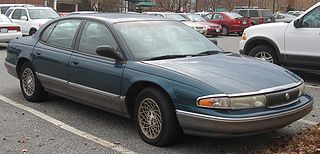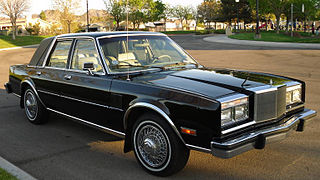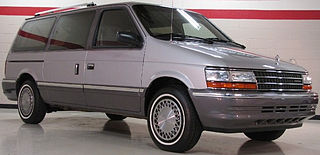
Plymouth was a brand of automobiles produced by Chrysler Corporation and its successor DaimlerChrysler. The brand was launched in 1928 to compete in what was then described as the "low-priced" market segment that was dominated by Chevrolet and Ford. It became the high-volume seller for the automaker until the late 1990s. Plymouth cars were marketed primarily in the United States. The brand was withdrawn from the marketplace in 2001. The Plymouth models that were produced up to then were either discontinued or rebranded as Chrysler or Dodge.

The Chrysler New Yorker is an automobile model that was produced by Chrysler from 1940 until 1996, serving for several decades as the brand's flagship model, or as a junior sedan to the Chrysler Imperial luxury brand. A trim level named the "New York Special" first appeared in 1938 and the "New Yorker" name debuted in 1939. The New Yorker name helped define the Chrysler brand as a maker of upscale models, priced and equipped to compete against upper-level models from Buick, Oldsmobile and Mercury.

The Chrysler Fifth Avenue was a trim level/option package or model name used by Chrysler for its larger sedans from 1979 to 1993. The Fifth Avenue name was no longer used after 1993 when Chrysler introduced its new LH-platform New Yorker and similar LHS. The title "Fifth Avenue" references a street in New York City in the United States which contains many upscale shops and cultural attractions.

The K-car platform was a key automotive design platform introduced by Chrysler Corporation for the 1981 model year, featuring a transverse engine, front-wheel drive, independent front and semi-independent rear suspension configuration—a stark departure from the company's previous reliance on solid axle, rear-drive body on subframe configurations. Derived from Chrysler's L-cars, the Plymouth Horizon and Dodge Omni, the platform was developed just as the company faltered in the market, at first underpinning a modest range of compact/mid-size sedans and wagons—and eventually underpinning nearly fifty different models, including all-wheel drive variants—and playing a vital role in the company's subsequent resurgence.

The Dodge Omni is a subcompact car that was produced by Chrysler Corporation from the 1978 to 1990 model years. The first Chrysler model line produced with front-wheel drive, the Omni and Horizon were also the first front-wheel drive economy cars assembled in the United States.
The B platform or B-body was the name of Chrysler's midsize rear-wheel drive passenger car platform from 1962 through 1979, and the name of a later, unrelated front-wheel drive platform used by the Eagle Premier / Dodge Monaco from 1988 through 1992.

Chrysler's C platform was the basis for rear wheel drive full-size cars from 1965 to 1978. Although often misclassified, 1964 and earlier full-size Chrysler products, and 1966 and earlier Imperials are not C-bodies.

The Chrysler minivans are a series of minivans that have been produced and marketed by the American automaker Chrysler since the 1984 model year. Currently in its sixth generation, the model line is marketed worldwide, primarily in North America and Europe. Introduced as the Dodge Caravan and Plymouth Voyager, the Chrysler minivans have been marketed under a variety of nameplates under the Chrysler, Plymouth, Dodge, and Ram brands; through the use of rebadging, the model line has also been marketed under the Lancia and Volkswagen brands.

The LH platform served as the basis for the Chrysler Concorde, Chrysler LHS, Chrysler 300M, Dodge Intrepid, Eagle Vision, and the final Chrysler New Yorker. A Plymouth to be called the "Accolade" was planned, but never saw production. The platform pioneered Chrysler's "cab-forward" design; featured on some Chrysler, Dodge, and Eagle cars in the 1990s and early 2000s.

The Chrysler M Platform was an intermediate-sized automobile platform used by Chrysler motors from 1977 to 1989. It was a successor to the F-body, as used on the Dodge Aspen/ Plymouth Volare. The M-body was also the successor to the short-lived R-body, as the Chrysler New Yorker and Plymouth Gran Fury moved to it following the R-body's demise in 1981. The M platform was the final production passenger car with a solid rear axle mounted on Hotchkiss-style, parallel semi-elliptical leaf springs sold in the U.S.

Full-size car—also known as large car—is a vehicle size class which originated in the United States and is used for cars larger than mid-size cars, it is the largest size class for cars. In Europe, it is known as E-segment or F-segment.

The Plymouth Fury is a model of automobile which was produced by Plymouth from 1955 to 1989. It was introduced for the 1956 model year as a sub-series of the Plymouth Belvedere, becoming a separate series one level above the contemporary Belvedere for 1959. The Fury was a full-size car from 1959 to 1961, then a mid-size car from 1962 to 1964, again, a full-size car from 1965 to 1974, and again, a mid-size car from 1975 to 1978. From 1975 to 1977, the Fury was sold alongside the full-size Plymouth Gran Fury. In 1978, the B-body Fury was the largest Plymouth, and by 1979, there was no large Plymouth. This was rectified in 1980 with the R-body Gran Fury, followed by the M-body Fury in 1982. Production of the last V8, RWD Plymouth Fury ended at Kenosha, WI, on December 23, 1988. Unlike its sibling brand, Dodge, Plymouth would not live to see the resurgence of the large, V8/RWD sedan.

The Dodge St. Regis is an automobile that was marketed by Dodge from the 1979 to 1981 model years. Replacing the Monaco, the St. Regis was the largest Dodge sedan, slotted above the mid-size Diplomat and Aspen. In contrast to both the Monaco and the Diplomat, the St. Regis was offered solely as a four-door sedan. Produced for a single generation, the St. Regis is one of the shortest-lived Dodge nameplates.

The Chrysler Town & Country is a luxury station wagon that was manufactured by Chrysler from 1940 to 1942 and from 1945 to 1988; production was interrupted during World War II. The Town & Country was briefly available as a "woodie" four-door sedan, two-door hardtop, and convertible body styles from 1947 to 1950, 1968-69 and from 1983 to 1986. The 1988 model year was the last for the station wagon until the 1990 model year when Chrysler reintroduced the Town & Country nameplate as the rebadged variant Chrysler Town & Country minivan.

The Plymouth Gran Fury is a full-sized automobile that was manufactured by Plymouth from 1975 to 1989. The nameplate would be used on successive downsizings, first in 1980, and again in 1982, through what would originally have been intermediate and compact classes in the early 1970s, all with conventional rear-wheel drive layouts. By the time Chrysler ended M-body production in December 1988, they were Chrysler's last remaining rear-wheel drive cars, with a V8 and carburetor, a configuration used since the mid-1950s. Plymouth did not have another rear-wheel drive car until the 1997 Prowler roadster.

The Newport was a name used by Chrysler for both a hardtop body designation and also for its lowest priced model between 1961 and 1981. Chrysler first used the Newport name on a 1940 show car, of which five vehicles were produced. The Newport continued the tradition of a large, comfortable luxurious coupe and sedan, while offering a modestly priced product in comparison to the Chrysler New Yorker and Chrysler Imperial. The Newport gradually replaced the Chrysler Windsor which originally replaced the Chrysler Royal. The Newport was initially the brand name for the Windsor with a hardtop body style, then was used for coupes, sedans and station wagons in later decades.
In the context of the automobile industry, downsizing is a practice used to transition vehicles from one size segment to another. Commenced during the Malaise era, downsizing is done in response to consumer and government demands influencing vehicle design. As vehicle product lines completed their model cycles, automobile manufacturers developed the next generation of a vehicle with a smaller exterior footprint to allow for weight reduction and increased fuel economy, using a shortened wheelbase and body length.

The first-generation Chrysler minivans are a series of minivans produced and marketed by the Chrysler Corporation from the 1984 to the 1990 model years. In a product introduction that would popularize the minivan as a vehicle in North America, Chrysler introduced the Dodge Caravan and the Plymouth Voyager, launched ahead of chief competitors Chevrolet Astro/GMC Safari and Ford Aerostar.

The second-generation Chrysler minivans are a series of minivans that were manufactured and marketed by Chrysler Corporation in North America and Europe from 1991 to 1995. Officially designated the AS platform by Chrysler, the second-generation minivans were an extensive revision of the first-generation chassis and body. As before, passenger and cargo configurations were sold by Dodge, Plymouth, and Chrysler divisions. The first minivans offered with driver-side airbags and with optional integrated child safety seats, the second-generation Chrysler minivans offered all-wheel drive as an option for the first time; a manual transmission would be offered for the last time in the North American market.

The third-generation Chrysler minivans are a series of passenger minivans that were marketed by the Chrysler Corporation from the 1996 to 2000 model years. Designated the NS platform by Chrysler, these minivans were sold by Chrysler, Dodge and Plymouth divisions in passenger configurations; minivans were exported under the Chrysler brand. While the second-generation AS platform was a revision of the original vans, the NS platform marked the first ground-up redesign of the Chrysler vans since their 1984 introduction, ending the use of components from K-Car derivatives.